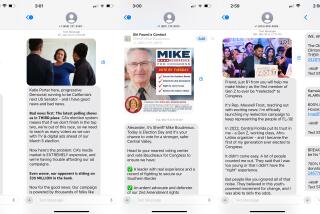Get the message? We luv 2 text
- Share via
Andrew Weigle can fully express himself in several dozen characters or less.
That’s the amount of space he gets on his Motorola Razr phone to compose text messages, which he sends mostly to friends and, on at least one occasion, to a girlfriend to break up.
“It was easier to say, ‘Look, things just aren’t working out’ ” over the text message, said Weigle, 23, of suburban Falls Church, Va. “I’m not the most verbal person when it comes to expressing emotions,” he admitted, but with text messaging, “I can put it out there and feel like I’m not saying it. I find there’s a little more freedom to say what you’re feeling.”
A generation ago, those kinds of missives came in handwritten form, taking days or weeks to arrive. Then e-mail made communication quicker but still allowed time and space for reflection.
Now, text messaging -- like its older cousin instant messaging -- is giving rise to a new, electronic written culture that is truncating all that. A text message sent via mobile phone is usually confined to 160 characters or less and takes several seconds to send. To accommodate this short form, language is acquiring acronyms -- “H8” (hate), “iluvu” (I love you) and “ruok” (are you OK) -- that allow text messages and other instant messages to relay information about life’s mundane details as well as its emotional brambles.
About 7.3 billion text messages are sent within the United States every month, up from 2.9 billion a month a year ago, according to CTIA, the wireless industry’s trade group. After Hurricane Katrina knocked out or overloaded communications systems, one of the only ways to reach lost relatives and friends was through text messaging, which transmits in sturdy little bursts of data that can often make it through even when voice lines are snarled.
Compared with an ink-and-paper letter, messages may seem disposable. The relative inconvenience of typing out words using a numeric keypad -- the letter c, for example, requires three presses of the 2 button -- and the brevity of the message may seem a hostile environment for heartfelt discussion. But the discipline of having to distill thoughts into short bulletins, then waiting to receive the response, allows users to pour more meaning into the writing, some text-message users say.
“There is something different about communications that are mediated by a piece of technology; it is easier to talk about difficult subjects, and that is both good and bad,” said Amanda Lenhart, senior researcher at the Pew Internet & American Life Project, who has interviewed many teenagers about how they use technology.
“You don’t see the person’s upper lip tremble. You don’t hear their voice quiver. You don’t get those external, non-textual cues,” she said, so delicate subjects might be easier to broach, if also easier to misunderstand.
Text-based intimacy went on display during a recent Bon Jovi concert at the MCI Center, when Sprint Nextel Corp. invited the audience to send in text messages, which then scrolled across a gigantic screen behind the stage, including proclamations of love, birthday shout-outs and even several marriage proposals.
The brevity of a text message gives it a certain poetic beauty, said Washington resident Erik Lung, 34. As in enigmatic haiku, there is lots of space for reading between lines, particularly in an early-stage romance.
“You can send a quick little message saying you’re thinking of her,” the operations research analyst said. Then “you start paying attention not only to what the message says, but you care about the response time.” There’s a meta-message: The shorter the response time, the more she cares.
Text messages also feel more personal because the cellphone is always physically close, Lung said -- a feature that works for and against him. He recently got into an argument with a friend who sent angry messages in all capital letters, berating him for ignoring her. “She started insulting me over text message ... and it was not a good scene,” he said. “Text messaging will catch you no matter where you are.”
Messaging alters language and composition style, said Tom Keeney, director of messaging for T-Mobile USA. Slang has gotten more detailed and sophisticated, making it possible to say more on a tiny canvas, he said. “It’s almost like letters gave way to postcards. It was a way to say something on the go.”
Text messaging became popular in the United States about three years ago, coinciding with the first television season of “American Idol,” which allowed viewers to vote for contestants by sending messages to the show. Now, almost a third of the country’s 200 million cellular phone subscribers use text messaging regularly for social or business purposes.
In a recent survey, more than 60% of U.S. adults used text messages to tell others they missed or loved them, according to a survey by Tegic Communications, a company that makes predictive-spelling software used on most U.S. cellphones. In the same survey, 27% said they used them to flirt, 7% to ask someone for a date, and 2% to break up. Two percent proposed marriage via text.
In Europe and Asia, where text-messaging started earlier, emotional messaging is more common, according to Tegic. Among Germans, 70% said “I love you” or “I miss you” over text; 13% of Italians and 12% of Chinese subscribers admitted to breaking up over text.






